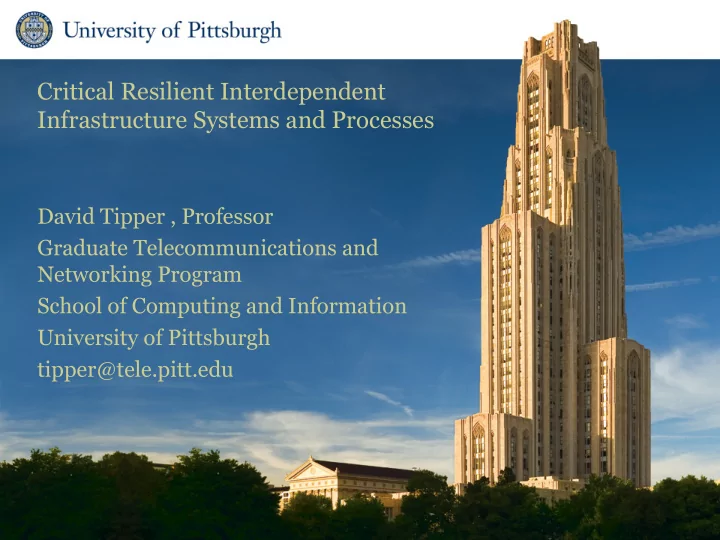

TeleNeT Program Critical Resilient Interdependent Infrastructure Systems and Processes David Tipper , Professor Graduate Telecommunications and Networking Program School of Computing and Information University of Pittsburgh tipper@tele.pitt.edu
Research and Teaching • Professor: Department of Informatics and Networked Systems, School of Computing and Information • Teach courses in graduate Telecommunications and Networking Program and grad/undergrad classes in Information Science Program – Network Performance – Network Design – Wireless Networks – Infrastructure Protection – Computer Networks • Educational/Curriculum funding – NSF, AT&T Foundation, Commonwealth of PA • Research Funding – NSF, NSA, ARO,NIST, DARPA, Bechtel Bettis 2
Research and Teaching 1. Resilient Networks – Wired/Wireless resilient network design • Spectrum pooling/virtualization • Quality of Resilience Classes • Risk Based Design – Cross Critical Infrastructure Resilience 2. Performance Evaluation Techniques – Modeling Dynamic Network Behavior: • Queueing and Simulation • Co-Simulation of cyberphysical systems – Recent work: V2V nets, MicroGrid power systems 3. Information Assurance – Network Security • DDOS – distributed detection, Key Management in Smart Grid Communications • Microgrid Security Architecture – Insider Attacks • Papers on Google Scholar page! 3
What is Critical Infrastructure? • Critical Infrastructures (CI) are the systems, assets and services upon which society and the economy depend, such as – Energy and utilities – Information Technology and Telecommunications – Critical Services (food, health care, financial) – Transportation – Government and Emergency Services – Etc. • DHS formalized government view of CIs in to sectors
Critical Infrastructure and Key Resources List of CI in Nat ’ l Strategy for The Physical Protection of CI and Key Assets, Feb 2003 à 17 later expanded to 18 Critical Infrastructures (CI) • Agriculture & Food • Water • Public Health • Emergency Services • Defense Industrial Base • Information Technology • Telecommunications • Energy Key Assets: • Transportation • Nat ’ l Monuments & Icons • Banking & Finance • Nuclear Power Plants • Chemicals & Hazardous Materials • Dams • Postal & Shipping • Government Facilities • Critical Manufacturing • Key Commercial Assets Now called Key Resources (KR)
Characteristics of CIs • Scale of many CIs are immense – Consider Power Grid in USA • More than 9,200 power plants/generating units • More than 300,000 miles of transmission lines • More than 1,000,000 miles of distribution lines • More than 170 power companies • Too expensive to protect everything • Can cross national boundaries/privately owned
Characteristics of CIs Each layer has a There are three layers in most CIs: degree of Cyber-Physical Systems! dependency on the other layers Organizational People Infrastructure Intra- e.g. Supervisor Control and Data dependency Acquisition (SCADA) systems. IT/Cyber - Infrastructure Physical Hardware: e.g., pipelines, Infrastructure transmission lines, etc. 7
Characteristics of CIs Interconnected CIs have a degree of interdependency between similar or other layers in other CIs Organizational Infrastructure Intra- dependency Cyber - Infrastructure Inter- dependency Physical Infrastructure Interdependency leads to a hierarchy of CIs
Hierarchy of Critical Infrastructures Defense Postal & Emergency Ag/Food Public Health Level 3 Industry Shipping Services Banking & Chemical Transportation Level 2 Finance Industry Information Tech. Level 1 Power/Energy Water & Telecom
Interdependence and Resilience • Research Focus on power grid + ICT – Joint reliability models • Failures in communications è Power Delivery • Failures in Power è Communications • Metrics mapping – downtime/week è SAIDI etc. • Designing reliable WANs for Smart Grid V. Kounev, M. Levesque, D. Tipper, and T. Gomes, • California ISO power grid “Reliable Communication Networks for Smart Grid Transmission Systems,” Journal of Network and – 3329 Substations, 75 utilities, Systems Management , Vol. 24, No. 3, pp. 629-652, 32,000 miles transmission line July, 2016. • Distance between substations – Min 1.2 miles, Max 1074 miles J. Silva, T. Gomes, D. Tipper, L. Martins and V. Kounev, “An Effective Algorithm for Computing All- terminal Reliability Bounds,” Networks, Vol. 66, No. 4, pp. 282-295, Dec., 2015. 10
Interdependence and Resilience • Microgrids: localized power grids with a clearly defined boundary • Operate connected to the main grid in an supplemental fashion or operate in island mode disconnected from the main grid for extended time periods. • Microgrid work – Reliable communication network design – Interaction of cybersecurity on power control algorithms V. Kounev, D. Tipper, A. Yavuz, B. Grainger and G. Reed, “A Secure Communication Architecture for Distributed Microgrid Control,” IEEE Transactions on Smart Grid, Vol. 6, No. 5, pp. 2484-2492, Sept., 2015.
Infrastructures in Smart Community Link economics/investment to reliability in Smart Community context 12
Comments • Cross Infrastructure Resilience on Campus Level – Microgrids, Smart X, etc. è Hidden ICT – Different vendors/protocols (IEC 61850, DNP3, Modbus, etc.) – Management (Facilities vs. IT) – Security often an afterthought • NSF Wireless Innovation for Networked Society (WINS) https://wirelesschallenge.mozilla.org/ • Smart Community Networks Challenge Challenge Provide wireless Internet Connectivity to underserved communities Working with local nonprofit METAMESH on submission 13
Recommend
More recommend